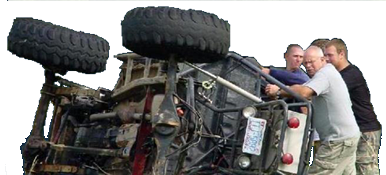To follow up on the build, I've continued to knock out the small brackets and mounts throughout the chassis. Just trying to keep things interesting as I wait on big components and wait for my wife to let me spend more money haha.
After getting the KC lights installed, I just stayed on the front trying to finish everything that would secure the front hood, cowl and fenders. I had to make a bracket that would tie the cowl down in the middle, so I fabricated a mount that not only secured the cowl but the hood hinges as well. With just a few bolts, we can take the hood and cowl off without wasting a lot of time.
As for the front of the hood, I simply installed some aluminum hood pins to keep the hood down. Definitely kept the pins themselves on a lanyard that way we don't loose them. Been there, done that too many times. As for the front fender, I just bent and welded some 1/4" solid rod to hold it in place. If nothing else, would be easy to bend back into place when its damaged.
As mentioned in my previous post, I've been awaiting a lot of ordered components. Some I still haven't seen, some I have. One of those orders was from Branik Motorsports. I'm sure most of you are aware of them, but if you aren't, they've got you covered for your axle needs. Go check them out. As you can see, they hooked us up with our sway bars and brakes.
I was basically like a kid in the candy store when they arrived, itching to get everything installed. So I worked on the rear sway bar first and finished with the rear brakes. Although I'm not 100% sure the rear will stay this way, I at least got this installed for now. Probably going a little wider since I ran into clearance issues. Started with full bump and full droop for measurements, just don't like the resting point at ride height.
As for the brakes, this was a simple install the hats and rotors on the unit bearing, cut my bracket to fit, center the pads, and make sure everything stayed straight as I tacked everything in place. Right now we're going with the 4 piston calipers as I already had 2 laying around, and leaves room for upgrades in the future.
During the whole sway bar/brake install, I did manage to fab up a couple of brackets for our rear light bar. Was a little bigger than I anticipated, so I had to move it further down. Works and allows for me to access the radiator cap without having to remove it.
As of right now, I've done the same things to the front, sway bars, brakes, etc. Hopefully installing lines and pedals in the near future.

